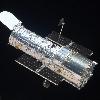

The Hubble Space Telescope as seen from the departing Space Shuttle Tags: Hubble Space Telescope View |
Hubble Space Telescope (HST) is a space telescope (space observatory) that was carried into orbit (Low Earth orbit) by a space shuttle (Space Shuttle) in April 1990. It is named after the American astronomer Edwin Hubble. Although not the first space telescope, Hubble is one of the largest and most versatile, and is well-known as both a vital research tool and a public relations boon for astronomy. The HST is a collaboration between NASA and the European Space Agency, and is one of NASAs Great Observatories (Great Observatories program), along with the Compton Gamma Ray Observatory, the Chandra X-ray Observatory, and the Spitzer Space Telescope.
Space telescopes were proposed as early as 1923. Hubble was funded in the 1970s, with a proposed launch in 1983, but the project was beset by technical delays, budget problems, and the Challenger disaster (Space Shuttle Challenger disaster). When finally launched in 1990, scientists found that the main mirror had been ground incorrectly, severely compromising the telescopes capabilities. However, after a servicing mission in 1993, the telescope was restored to its intended quality. Hubbles orbit outside the distortion of Earths atmosphere allows it to take extremely sharp images with almost no background (background (astronomy)) light. Hubbles Ultra Deep Field (Hubble Ultra Deep Field) image, for instance, is the most detailed visible-light (visible spectrum) image ever made of the universes most distant objects. Many Hubble observations have led to breakthroughs in astrophysics, such as accurately determining the rate of expansion of the universe (Hubbles law#Using Hubble space telescope data).
Hubble is the only telescope ever designed to be serviced in space by astronauts. Four servicing missions were performed from 1993-2002, but the fifth was canceled on safety grounds following the OVColumbia disaster (Space Shuttle Columbia disaster). However, after spirited public discussion (#Debate over final servicing mission), NASA administrator Mike Griffin (Michael D. Griffin) approved one final servicing mission (STS-125), completed in 2009. The telescope is now expected to function until at least 2014, when its successor, the James Webb Space Telescope (JWST), is due to be launched.
Organization: NASA\ESA (European Space Agency)\STScI (Space Telescope Science Institute)
Nssdc Id: 1990-037B
Orbit Type: Near-circular low Earth orbit
Height: 5.59 Mtr
Inclination: 28.5 degrees
Period: 96-97 minutes
Velocity: convert7500m/sabbr=on
Accel Gravity: convert8.169m/s2abbr=on
Birth Location: Low Earth orbit
Launch Vehicle: Space Shuttle Discovery, (STS-31)
Launch Date: 24 April 1990, 8:33:51 am EDT (Eastern Daylight Time)
Mission Length: For year month day year=1990 month=04 day=24 elapsed
Deorbit Date: due ~ 2013-2021
Wavelength: Optical, ultraviolet, near-infrared
Mass: convert11110kgabbr=on
Style: Ritchey-Chr�tien reflector
Diameter: convert2.4mabbr=on
Area: convert4.5m2abbr=on
Focal Length: convert57.6mabbr=on
Instrument 1 Name: NICMOS (Near Infrared Camera and Multi-Object Spectrometer)
Instrument 1 Characteristics: infrared camera/spectrometer
Instrument 2 Name: ACS (Advanced Camera for Surveys)
Instrument 2 Characteristics: optical survey camera,(partially failed)
Instrument 3 Name: WFC3
Instrument 3 Characteristics: wide field optical camera
Instrument 4 Name: COS (Cosmic Origins Spectrograph)
Instrument 4 Characteristics: ultraviolet spectrograph
Instrument 5 Name: STIS (Space Telescope Imaging Spectrograph)
Instrument 5 Characteristics: optical spectrometer/camera
Instrument 6 Name: FGS (Fine Guidance Sensor)
Instrument 6 Characteristics: three fine guidance sensors
Website: hubble.nasa.gov/

